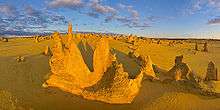The Pinnacles (Western Australia)

The Pinnacles are limestone formations within Nambung National Park, near the town of Cervantes, Western Australia.[1]
Formation

The raw material for the limestone of the Pinnacles came from seashells in an earlier era that was rich in marine life. These shells were broken down into lime-rich sands that were blown inland to form high mobile dunes.[2] However, the manner in which such raw materials formed the Pinnacles is the subject of debate and three theories have been proposed.
The first theory states that they were formed as dissolutional remnants of the Tamala Limestone, i.e. that they formed as a result of a period of extensive solutional weathering (karstification). Focused solution initially formed small solutional depressions, mainly solution pipes, which were progressively enlarged over time, resulting in the pinnacle topography. Some pinnacles represent cemented void infills (microbialites and/or re-deposited sand), which are more resistant to erosion, but dissolution still played the final role in pinnacle development.[2][3]
A second theory states that they were formed through the preservation of tree casts buried in coastal aeolianites, where roots became groundwater conduits, resulting in the precipitation of indurated (hard) calcrete. Subsequent wind erosion of the aeolianite then exposed the calcrete pillars.[4]
A third proposal suggests that plants played an active role in the creation of the Pinnacles, based on the mechanism that formed smaller “root casts” in other parts of the world. As transpiration drew water through the soil to the roots, nutrients and other dissolved minerals flowed toward the root—a process termed "mass-flow" that can result in the accumulation of nutrients at the surface of the root, if the nutrients arrive in quantities greater than that needed for plant growth. In coastal aeolian sands that consist of large amounts of calcium (derived from marine shells), the movement of water to the roots would drive the flow of calcium to the root surface. This calcium accumulates at high concentrations around the roots and over time is converted into a calcrete. When the roots die, the space occupied by the root is subsequently also filled with a carbonate material derived from the calcium in the former tissue of the roots, and possibly also from water leaching through the structures. Although evidence has been provided for this mechanism in the formation of root casts in South Africa, evidence is still required for its role in the formation of the Pinnacles.[5]
Tourism
The Pinnacles remained unknown to most Australians until 1967 when the area was gazetted as a reserve, which was later combined with two adjacent reserves to form Nambung National Park in 1994.[6] As of 2011, the national park received about 150,000 visitors a year. A visitor precinct and interpretive centre was opened in October 2008.[7]
The best season to see the Pinnacles is spring from August to October, as the days are mild and wildflowers start to bloom. The pinnacle formations are best viewed in the early morning or late afternoon as the play of light brings out the colours and the extended shadows of the formations delivers a contrast that brings out their features. Most animals in the park are nocturnal, but emus and kangaroos can be seen during the daytime, more commonly in the evening or early morning.
In popular culture
The Pinnacles were featured in Billy Connolly's World Tour of Australia at the climax of an episode, he dances around them in the nude echoing an Aboriginal creation story which relates to the Pinnacles. It was also featured in the musical number "Ye Jaan Le Le" in the 1997 Indian film, Daud, starring Sanjay Dutt and Urmila Matondkar.
Additionally, the music video for the song "Standing on the Shore" by Australian electropop duo Empire of the Sun, also featured The Pinnacles.
Several scenes in the 2009 Korean thriller movie A Million were filmed there.
References
- ↑ "Nambung National Park". Department of Parks and Wildlife. Archived from the original on 2016-09-15. Retrieved 2016-09-15.
- 1 2 Lipar, M., Webb, J.A., 2015. The formation of the pinnacle karst in Pleistocene aeolian calcarenites (Tamala Limestone) in southwestern Australia. Earth-Science Reviews 140, pp. 182-202
- ↑ Lipar, M., 2009. Pinnacle syngenetic karst in Nambung National Park, Western Australia. Acta Carsologica 38 (1), pp. 41–50.
- ↑ Hearty, P.J., O’Leary, M.J., 2008. Carbonate eolianites, quartz sands, and Quaternary sea-level cycles, Western Australia, A chronostratigraphic approach. Quaternary Geochronology 3, 26-55
- ↑ Cramer MD, Hawkins H-J. 2009. A physiological mechanism for the formation of root casts. Palaeogeography, Palaeoclimatology, Palaeoecology 274: 125–133
- ↑ "Nambung National Park Management Plan 1998-2008" (PDF). Department of Conservation and Land Management, National Parks and Nature Conservation Authority. 1998. p. 14. Archived from the original (PDF) on 2011-03-12. Retrieved 2016-04-07.
- ↑ "Nambung National Park (Pinnacles)". Department of Environment and Conservation (naturebase.net). Archived from the original on 2011-02-19. Retrieved 2016-04-08.
Further reading
- Stephens, Alan.(1989) Pinnacles : Nambung National Park, Western Australia (photography, Alan Stephens - text, Sue Hughes) Mulgrave, Vic. : Nucolorvue Productions, ISBN 0-85858-106-X
External links
| Wikimedia Commons has media related to Nambung National Park. |
- Official website - Department of Parks and Wildlife page for Nambung National Park
- Google Streetview - 360 degree interactive journey through the Pinnacles
Coordinates: 30°36.35′S 115°9.45′E / 30.60583°S 115.15750°E